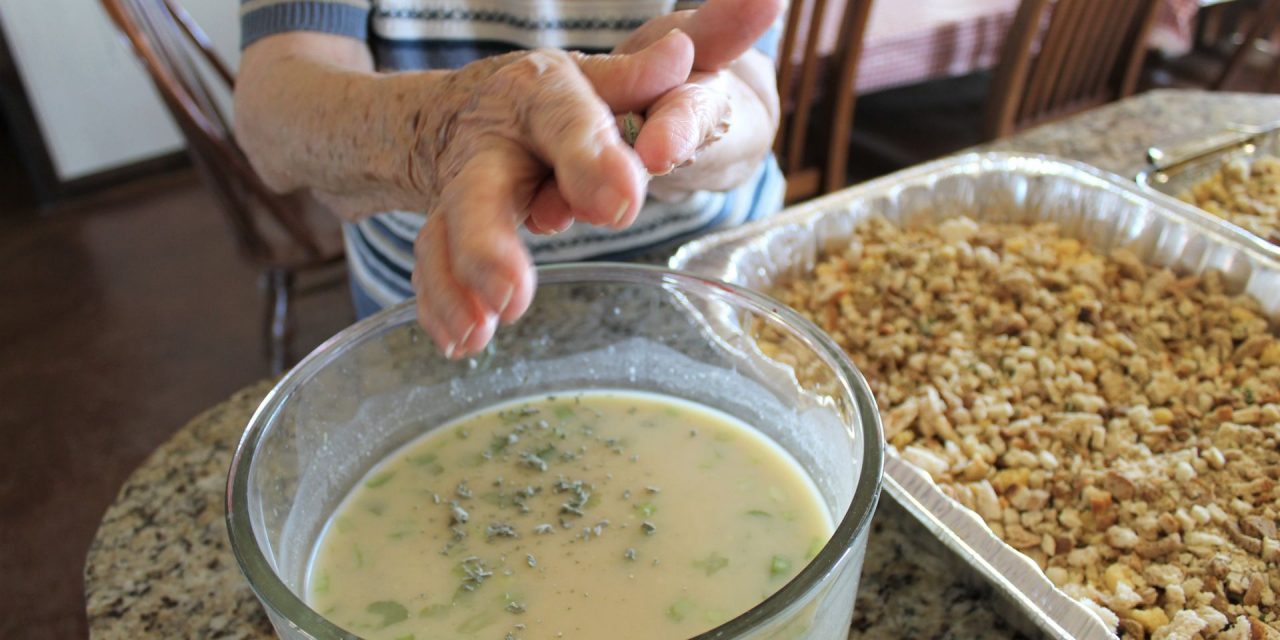Most people think that their Grandma is the best, and I am no different! My Grandma was born in 1919, and spent her entire life caring for others. We were blessed to have her until she went home to Jesus at the blessed age of 98. She went to great lengths to ensure that our holidays were filled with delicious food, laughter, stories and lots of love. I can remember being a child and crawling into our car with such excitement to go to her house for Thanksgiving. It was packed with enough stuff to stay for weeks even though we were only going for the weekend.
On the way to her house, my parents, my sister and I would all try to guess how many homemade pies she would have, and my Dad and I would always argue over who was going to get the first piece of her famous egg custard pie! Her house always smelled “just right” and seemed to be extra warm. Most generally, she would have a big stew ready upon our arrival, and the next day would be spent preparing the “big meal.”
One of my favorite memories is when I would watch her take fresh sage leaves that had been carefully dried and crumble them to make the dressing. While rubbing the sage in the palm of her hands, she would always tell me the same story. She would say, “Lori, you know that Great Grandma (her mother) always had a sage bush in her yard. When I was a little girl, I remember watching her pluck the good leaves, wash them under cool water and carefully lay them out on a tea-towel in the cellar to dry. When they were dry, she would place the whole leaves in a quart canning jar and store them for later use. Every third or fourth year, she would plant a new sage bush just to make sure that she always had one.”
Grandma loved the camphor smell of sage and would emphasize the fact that, “Dressing is no good unless it has lots of fresh sage in it!” I listened intently and learned. Little did I know that she was teaching me the benefits of gardening and the basics of herbalism.
Common garden sage (Salvia officinalis) is one of the easiest perennial herbs to grow in Oklahoma. It is an evergreen, woody shrub that has grayish-green leaves and blooms with purplish flowers in the spring. It is a member of the mint family, even though most people don’t relate the two together. Sage prefers to live in a sandy loam soil that drains well. It does not like to be in soggy soil and it is extremely heat tolerant. It has no problem enduring the hot summers of central Oklahoma.
Sage is easy to integrate into your landscape and can be used as a native plant in pollinator-friendly gardens or as a staple plant in more formal designs. One of the best things about common garden sage is that its leaves dry and store very well. Other varieties, such as Berggarten sage, grow well, but their leaves don’t retain the camphor characteristic for very long after being dried. Sage is used as a culinary and medicinal herb and is one that we would not consider doing without. I am so thankful that I was taught this growing up.
As we reflect on things that we are thankful for, I hope that you’ve been blessed with happy memories of your loved ones. Even though I know that my Grandma loved us dearly, there is One whose love for us far surpasses anything that she could have ever demonstrated. “But God demonstrates His own love toward us, in that while we were still sinners, Christ died for us” (Rom. 5:8).
My dear friend, let me tell you that God loves you! He made you in His image, and He does care about what happens to you. “For God so loved the world that He gave His only begotten Son, that whoever believes in Him should not perish but have everlasting life” (John 3:16). Allow yourself to experience His love. Happy Thanksgiving!





